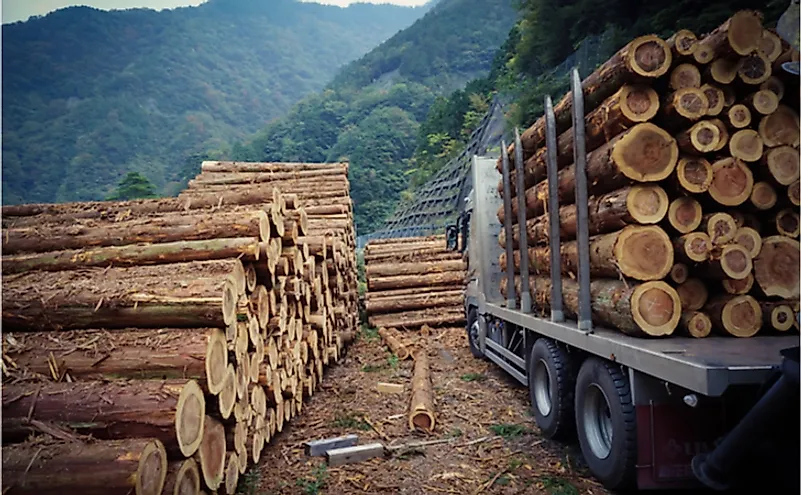What Are The Differences Between Hardwood And Softwood?

Wood is generally categorized as either softwood or hardwood, and it is a common misconception that softwood is soft and workable while hardwood is hard and durable. However, this is not what qualifies a piece of wood as either soft or hard. For example, balsa wood is known as one of the softest and least dense types of wood, yet it is categorized as hardwood. Similarly, wood from the yew tree, which is one of the toughest woods and is harder than most types of oak, is classified as softwood. Wood is categorized as either softwood or hardwood based on physical structure and makeup.
Key Difference Between Hardwood and Softwood
The primary distinction between hardwood and softwood is based on the reproductive biology of the tree species. More specifically, the type of seeds produced by a tree determines whether it is hardwood or softwood. Trees with seeds that are enclosed, such as within a shell or fruit, are categorized as hardwood. In contrast, trees with seeds that are not enclosed are softwood. Additionally, trees with enclosed seeds are known as gymnosperms, while those with unenclosed seeds are called angiosperms.
What Is Hardwood?
Angiosperms are plant species that contain seeds within an ovary-like structure, such as a hickory nut. These species are also non-monocots, meaning that they have more than one leaf when they sprout. The woody stems of hardwoods have vascular tubes that are used to transport water throughout the tree. When a cross-section of an angiosperm is viewed under a microscope, it appears to contain pores. These pores-like structures create a wood grain pattern that increases the density of the wood. Hardwoods are generally denser than softwoods.
Characteristics of Hardwood
Angiosperm plants typically have broad leaves, and most species are deciduous trees. These plants tend to grow in temperate regions, shed their leaves during autumn when temperatures drop and remain dormant during winter. However, angiosperms in tropical regions may also shed leaves as a result of sporadic or seasonal periods of drought and rain. Deciduous trees, such as species of oak, exhibit yearly growth rings that may be absent in tropical hardwoods. Compared to softwoods, hardwoods have a complex structure and grow slowly. The most prominent feature among hardwood species are pores, which are typically vessels. These pores can range significantly in shape, size, and perforation plates, and can be foraminate, reticulate, scalariform, or simple pores. They also exhibit significant differences in wall cell structure, such as spiral thickenings.
What Is Softwood?
Gymnosperm plants are softwood trees and are known as "naked" seed plants because their seeds are not enclosed within a nut or fruit. Species of softwood trees include spruces, firs, and pines, which have seeds in cones. The seeds of conifers are typically released into the wind once they mature, and this type of seed dispersal ensures that the seeds are distributed over a larger area, providing an advantage over hardwood species. Unlike hardwoods, softwoods do not have pores, but instead contain linear tubes, known as tracheids, which supply nutrients for growth. Tracheids perform the same function as the pores in hardwood trees, and also produce sap, which protects the trees from pests and transports water and other essential elements necessary for growth. Softwood trees generally grow faster than hardwoods and are usually less dense.
Characteristics of Softwood
Softwood trees do not have broad leaves, but rather have needle-like leaves. They are generally evergreen, meaning that they do not shed their leaves in the fall and do not become dormant during winter. Softwood trees have medullary rays and tracheids, and when observed under a microscope, they do not appear to have pores like hardwoods. Softwood is primarily used in construction framing, the production of pulpwood for paper, and other items such as fiberboard, plywood, and particleboard.
Hardness of Wood
Determining the hardness of a piece of wood is achieved through the Janka hardness test. This metric, which was developed by Gabriel Janka, measures the resistance of wood against wear and denting. It measures the amount of force needed to embed a steel ball with a diameter of 0.44 in halfway into a given piece of wood. The standardized results acquired are used as a relative measure of the hardness of a given wood, which can be used to determine if a species of wood is suitable for certain uses in construction. The test is typically performed on wood derived from the trunk of the tree, which is known as the heartwood, and samples should have a moisture content of at least 12% and be clear of knots. The hardness of wood varies significantly with the direction of the wood grain. Side hardness refers to testing conducted on a plank wood perpendicular to the grain, while end hardness refers to testing on the surface of a cut stump. There are also other types of testing, such as radial hardness and tangential hardness.











